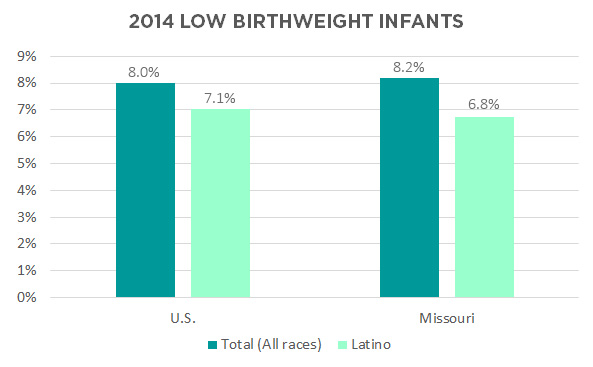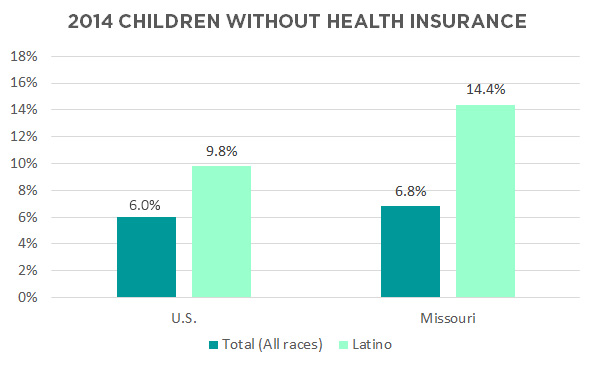Latino/a Children in Missouri
“As the creators and leaders of tomorrow, all children are vital to our country’s growth, prosperity and well-being. This includes 18 million children and youth who are sons and daughters of immigrants or are immigrants themselves”—The Annie E. Casey Foundation
The Annie E. Casey Foundation (AECF) recently released a statement addressing the burden of current executive actions on immigrant families. The foundation also prepared a report on policies to improve immigrant children outcomes. In support of the foundation’s commitment to ensure that all children have equal opportunity to prosper, the Missouri KIDS COUNT decided to prepare this article to highlight Latino children and families living in Missouri as they represent one of the largest minority groups in our state.
The article begins with a summary of current demographic trends for Latinos at the national and state level. We then present data on selected outcomes for Latino children with the purpose of providing an overview of how they are faring in comparison to Latino children living in the U.S. Lastly, we highlight how Latinos culturally enrich our communities and their major contributions to Missouri’s economy.
DEMOGRAPHIC TRENDS: LATINO CHILDREN IN THE UNITED STATES
Over the past 15 years, the number of Latino children1 has dramatically increased in the U.S. According to the Population Reference Bureau, in 2015, there were 18.2 million Latino children (under 18 years) living in the U.S. Furthermore, between 2000 and 2015, the number of Latino children increased by 47%. The table below presents population changes for Latino children in comparison to children from other major racial/ethnic groups.

In 2015, Latino children accounted for one-quarter (25%) of all children (under 18 years) in the U.S., but as projected by The National Council of La Raza, they are expected to make up almost one-third (32%) of the child population by 2050. Based on these projections, it is expected that by 2050 one in every three children will be of Latino heritage.
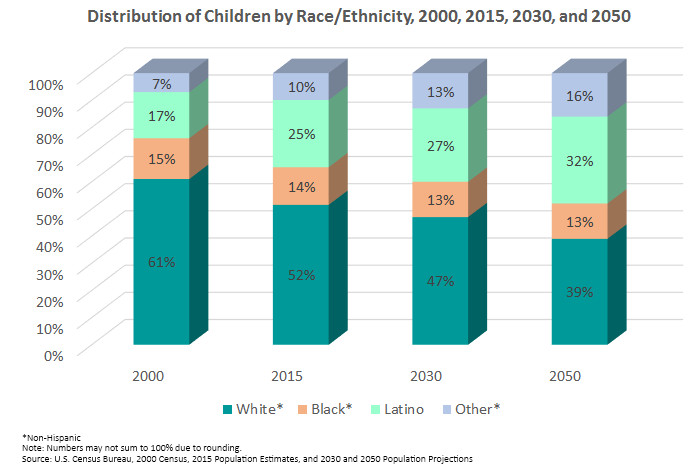
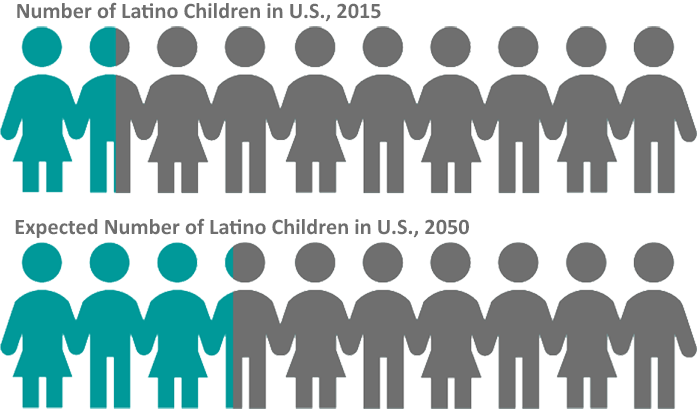
Source: National Council of La Raza
According to the Pew Research Center, an overwhelming majority of Latino children (94%) are U.S.-born citizens, who are English proficient (87%) with many speaking only English at home. The high proportion of U.S.-born Latino children has been attributed to the fact that most Latino immigrants arrive this country as working adults—not as children. For instance, in 2014, only 6% of foreign-born Latinos were children (under 18 years old), while the majority (37%) were Generation ‘X’ (34 to 49 years old).

Even though most Latino children are U.S.-born citizens, they live in immigrant families who have at least one parent who is not U.S.-born. For example, according to Child Trends, in 2014, forty percent of children in immigrant families had at least one parent who was born in Mexico. Children living in immigrant families face numerous challenges that can threaten their overall development, including having undocumented parents, low parental educational attainment, living in poverty, and inadequate insurance coverage.
DEMOGRAPHIC TRENDS: LATINOS IN MISSOURI
Based on a state demographic profile prepared by the Pew Research Center, in 2014, the Latino population in Missouri was 232,000, which represents 4% of the overall state population. In line with trends at the national level, most Latinos in Missouri are young (median age=25 years), U.S.-born citizens (74%).
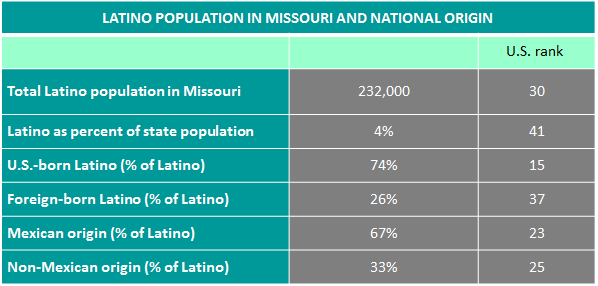
Adapted from: Pew Research Center Hispanic Trends – Demographic profile of Hispanics in Missouri, 2014
Missourian Latinos are a vibrant, culturally diverse group2. The majority trace their heritage back to Mexico, followed by Central American and Caribbean countries. As can be seen in the table below, in Missouri the majority of Mexican and Caribbean Latinos are U.S.-born; half of South American Latinos are U.S.-born, while the majority of Central American Latinos are foreign-born.
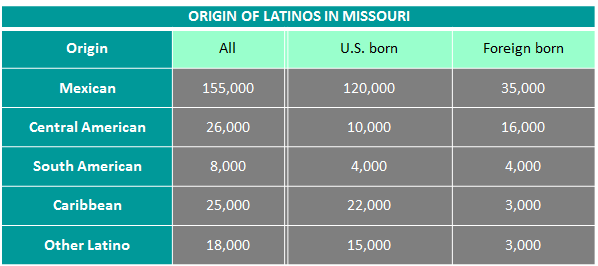
Adapted from: Pew Research Center Hispanic Trends – Characteristics of the Population in Missouri, by Race, Ethnicity, and Nativity: 2014
LATINO CHILDREN IN MISSOURI
In 2015, more than six percent of all children (under 18 years of age) in Missouri were Latino—this represents more than 91,000 children.
*Non-Latino ethnic heritage persons. “Other” includes American Indian/Alaska Native, Native Hawaiian and Other Pacific Islander, Asian American, and Multiracial.
Source: National Council of La Raza (Data Explorer).
From 2000 to 2015, the percent of Latino children (under 18 years) in Missouri increased from 3% to 6.4%. That is, the number of Latino children in our state more than doubled within the span of 15 years. The table below compares child population growth by racial/ethnic group. As can be seen, Latinos children had the fastest growth rate of all groups, while the number of White and Black children declined. Based on these trends, the number of Latino children in Missouri can be expected to continue increasing rapidly.
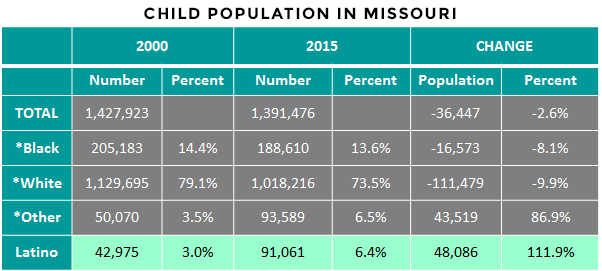
*Non-Latino ethnic heritage persons. “Other” includes American Indian/Alaska Native, Native Hawaiian and Other Pacific Islander, Asian American, and Multiracial.
Source: National Council of La Raza (Data Explorer).
HOW ARE LATINO CHILDREN FARING IN OUR STATE?
The National Council of La Raza in partnership with the Population Reference Bureau released a report last year summarizing the trends and challenges faced by Latino children in the U.S. In this section, we highlight a few of the child indicators included. In our figures, we compared Missouri Latino children against the state average as well as the national average. Data for all the indicators presented in this section comes from the National Council of La Raza data explorer tool.
Health
- The percent of Missouri Latino children born with low birth weight is lower than the state and national average.
The finding that Latinas have healthy children despite living in disadvantaged circumstances has been referred to as the Latina paradox. Specifically, given that Latinas are more likely to have low educational attainment, live in low income families, and have poor access to prenatal care—all factors associated with low birth weight—it would be expected that Latino children would be at higher risk for low birth weight. Several explanations have been offered to clarify this paradox, including that Latinas learn healthy prenatal practices from their female kinship, including best foods to eat while pregnant, prenatal care, and well-being.
Source: National Council of La Raza (Data Explorer).
- Although the number of children without health insurance has declined as result of recent changes to children’s health insurance programs, the number of Missouri Latino children without health insurance remains relatively high.
Specifically, the percent of Missouri Latino children without health insurance coverage more than doubles the state average. Also, the percent of Missouri Latino children without health insurance is higher compared to the percent of Latino children at the national level. The lack of health insurance among Latino families will likely continue contributing to the growing health disparities in our state.
Source: National Council of La Raza (Data Explorer)
Education
- Compared to the state average, more Missouri Latino children have a mother who has low educational attainment.
Specifically, the percent of Missouri Latino children who have a mother with less than high school education more than doubles the state average. Compared to the national percent for Latinos, however, the percent of Missouri Latino children with a mother who has less than high school education is slightly lower.
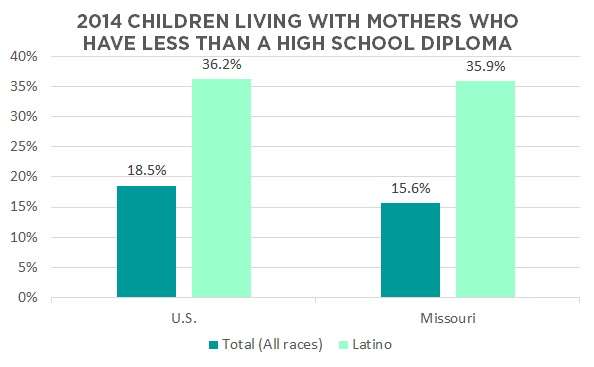
Source: National Council of La Raza (Data Explorer)
- Interestingly, the percent of Missouri Latino children who graduated in time from a public high school is higher than that of Latino children at the national level.
More information is needed to determine why more Latino children in Missouri are completing high school on time when compared to national rates.

Source: National Council of La Raza (Data Explorer).
Based on the indicators presented, Missouri Latino families face significant challenges, but continue to thrive. More information on family and child indicators is needed to understand better how Latino families are faring in our state and to make informed decisions on how to support Latino children in becoming healthy and productive adults.
HOW DO LATINOS CONTRIBUTE TO OUR STATE?
Cultural and Linguistic Diversity
Missouri Latinos are a culturally rich group with diverse historical experiences. While the majority of Latinos living in our state are U.S.-born and others have resided in the U.S. for many generations, many still hold strong ties to Latin American countries, as reflected in their traditions and language use. Also, Latino parents may choose to raise their children following values that are esteemed in traditional Latino culture or values embedded in the heritages of both their native origin heritage and the heritage of the mainstream society.
- More than half of Missouri Latinos speak only English at home, while many other Latino families speak other languages at home, mainly Spanish.
Thus, Latinos enrich the cultural and linguistic diversity of our state by interacting with other members of our communities and exposing them to diverse traditions, values, and languages.
Support Economic Growth
Latinos are integral to Missouri’s economy as they are responsible for billions of dollars in tax revenue and consumer purchasing power.
- In 2013, Latinos paid $498 million in federal taxes and $245 million in state and local taxes.
- The purchasing power of Latinos in Missouri was estimated to be $5.4 billion in 2014.
These numbers are expected to continue to increase as the Latino population and the buying power of Latinos in Missouri increase. For example, the number of Latino-owned business has increased in the state, particularly in Kansas City, where Latino business ownership increased by 40% between 2008 to 2015.
Military Involvement
Latinos have a long history of supporting the U.S. military services. Within the past 30 years, the representation of Latinos in the Army increased from 3% to 17%. In 2016, Latinos were the largest ethnic minority group in the Marine Corps, including 1,340 men and women.
- In 2015, approximately 12% of all active-duty military were Latino—which is three times the percent of 1980.
Given the rapid growth of the Latino population, it is likely that their military representation will continue to increase.
CONCLUSIONS AND RECOMMENDATIONS
Latino children and their families continue to flourish and contribute significantly to our communities, economy, and social well-being. However, there are remaining challenges including:
- More research is needed to identify the strengths and challenged they face in our state. Such information is imperative for making informed decisions about how to promote healthy child development and how to wisely invest in Latino child well-being.
- Researchers, state and community agencies, and policy makers must work together to develop more effective evidence-based policies and programs to better integrate our communities and improve the quality of life for all Missourians.
- More work is needed to identify ways to protect Latino children against adversity. For example, fostering pride in one’s own ethnic heritage (i.e., ethnic identity) has been found to protect children against ethnic/racial discrimination experiences. Also, supporting Latino parents to teach their children about their own ethnicity and ethnic-based values (e.g., familism, or importance of maintaining a strong family connection) has been found to be helpful in coping with discrimination.
- A recent report highlights how mental health interventions for Latino youth are beginning to incorporate some of these culture-related factors to provide more effective services.
Individuals interested in promoting the well-being of all Missourians, including Latinos and other ethnic and racial minority children, should invest in fostering these factors.
RESOURCES
State/Local Resources:
Alianzas (Alliances), University of Missouri-Kansas City
Cambio Center, University of Missouri
Centro Latino de Salud
Guadalupe Centers
Hispanic Chamber of Commerce of Greater Kansas City
Hispanic Chamber of Commerce of Metropolitan of St. Louis
National Resources:
American Immigration Council
National Council of La Raza
Pew Research Center—Hispanic Trends
United States Hispanic Chamber of Commerce
Child Trends—Immigrant Children
Suggested Citation:
Martinez, M. M., Carlo, G., Maiya, S., & Hines, L. (2017, December). Latino/a Children in Missouri. Family and Community Trust (FACT)—Missouri KIDS COUNT. Available at: http://mokidscount.org/stories/latino-a-children-in-missouri/
Acknowledgments: We would like to thank everyone who contributed to the article. We are grateful to the University of Missouri Center for Family Policy and Research for their expertise.
Funding for this research is generously provided by the Annie E. Casey Foundation. We thank them for their support but acknowledge that the findings and conclusions presented in this report are those of the author(s) alone, and do not necessarily reflect the opinions of the Foundation.
Footnotes
[1] Defined as any person of Latin American descent living in the U.S. Latino refers to the heritage of a person, not race.
[2] To learn more about the history of Latinos in Missouri, see this report prepared by the Cambio Center at the University of Missouri.
Download Latino/a Children in Missouri
December 7, 2017



